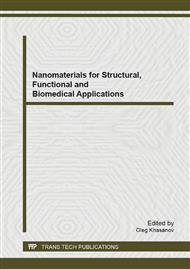p.79
p.84
p.89
p.94
p.106
p.112
p.118
p.123
p.128
The Influence of Zn3(PO4)2:Mn - Luminophores Synthesis Conditions on their Surface and Luminescent Features
Abstract:
A technology, that allows production effective x-ray luminescent phosphors Zn3(PO4)2:Mn2+ with nanosized particles from the water solution by sol-gel method, and directional regulated their luminescence color from green to red was developed. X-ray intensity and spectra, phase structure, and surface properties of synthesized samples depending on the synthesis conditions was studied. The conditions of synthesis which allow to obtain the samples according to the demands for the luminophores of medical assignment were determined.
Info:
Periodical:
Pages:
106-111
Citation:
Online since:
December 2013
Price:
Сopyright:
© 2014 Trans Tech Publications Ltd. All Rights Reserved
Share:
Citation:


